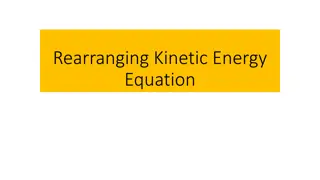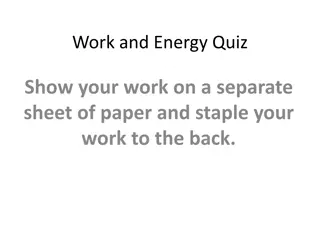Exploring Motion through Kinetic Art
Delve into the world of motion with a focus on kinetic art, inspired by the artwork of Latvian artist Valdis Celms. Discover how objects move, the forces that drive their motion, and engage in hands-on activities like creating rotating mechanisms. Through Valdis Celms' kinetic wall sculpture "Positron," learn how art and science intersect to showcase the beauty of movement.
Download Presentation

Please find below an Image/Link to download the presentation.
The content on the website is provided AS IS for your information and personal use only. It may not be sold, licensed, or shared on other websites without obtaining consent from the author. Download presentation by click this link. If you encounter any issues during the download, it is possible that the publisher has removed the file from their server.
E N D
Presentation Transcript
WHAT CAUSES MOTION? Based on Latvian artist Valdis Celms' artwork Positron.
Kinetic art is art that relates to motion. The artist Valdis Celms is one of the kinetic art pioneers in Latvia.
Kinetic Art Positron by Valdis Celms is a large kinetic wall sculpture. Its metal structure is made of two spheres. At the centre is a hidden motor which causes the structure to slowly rotate.
Learning outcomes: To know what causes objects to move or change their movement To create a rotating mechanism and observe the motion
What do you do when you are in motion? What tools do you use to move around in winter compared to summer?
How do objects move? For an object to move, a force must be applied to it. The force may cause the object to move faster or slower, change direction, or stop completely. Movement is started and maintained by traction. An object stops when there is no longer a force being applied to it.
Paper windmill You will need: a pencil with an eraser pins a ruler paper scissors
Paper windmill Where is the traction? In what direction is the traction aimed? In what direction is the windmill moving? Clockwise or anticlockwise? What makes the windmill rotate clockwise, and what makes it rotate anticlockwise?
Which windmill will rotate clockwise, and which will rotate anticlockwise? A B
How can we make it rotate better? How securely does the pin need to be fastened? What do we call the force that makes objects move?
What do you think the world would look like without motion?
Thank you! Learning kit by L ga Za e Design: Kri s Salmanis Commission: Association R GAS STARPTAUTISK BIENN LE The Erasmus+ project RIBOCA Repository of Knowledge is co-financed by the European Union. The European Commission is not responsible for the content of this publication.























